- Manufacturer: Swedese Möbler AB
- Designer: Thomas Bernstrand
- Material: aluminium
- Dimensions: 66 × 36 × 37
- www.swedese.se

Index
- Thomas Bernstrand Born in 1965 in Stockholm, Thomas Bernstrand runs his design studio Bernstrand & Co in Stockholm. Trained at Konstfack, University College of Arts, Cr
- Swedese Swedese is a Swedish furniture producer with a strong anchor in both the public and domestic domain. It was founded in 1945 by the two brothers Yngve
- Manufacturing Technology Computer Numerical Control Numerical control (NC) refers to the automation of machine tools that are operated by abstractly programmed commands encode
- Accidents Tests According to Consumer Product Safety Commission (CPSC) accident estimates, tens of thousands of stepladder accidents requiring emergency room tr
- Safety Safety Tips Only choose ladders with the UL seal from Underwriter's Laboratory. Ladders commonly come in three materials: aluminum, wood, or fiberglas
- Previous Designs "Heaven" uses a novel construction technique, where the steps cantilever up from the base. This is unique in comparison with existing stepladders. Lib
- Worlds Tallest Man World's tallest man marries small woman Wednesday, March 28, 2007 After searching high and low, the world's tallest man has got married to a woman ha
Born in 1965 in Stockholm, Thomas Bernstrand runs his design studio Bernstrand & Co in Stockholm. Trained at Konstfack, University College of Arts, Crafts & Design in Stockholm, 1994-1999, Danmarks Designskole, 1996, and the Royal Academy of Fine Arts in Stockholm, 2005-2006. The distinguish of Thomas Bernstrands design is that it is always basted on a strong idea with a humours touch. Thomas never compromises and he always stick to his basic idea. And with this strong idea Thomas doesn't need to covering up anything. For his work he has received the following design prizes and awards: Excellent Swedish Design (twice), the Spanish cDIM Design Award 2004, Ann Wall Design Prize 2005, Sköna Hem Furniture of the Year, 2005, and Imm Interior Innovations Award (Germany), 2005. He has taken part in several art and design exhibitions around the world, including MoMA in New York, Colette in Paris, Biennale Design Saint-Etienne, etc. Thomas works on commissions for several Swedish and international companies, such as IKEA, Swedese, Askul, Muutu, Droog, among others.
Swedese is a Swedish furniture producer with a strong anchor in both the public and domestic domain.
It was founded in 1945 by the two brothers Yngve and Jerker Ekström and Sven Bertil Sjöqvist, with Yngve leading the company until his death. The present owner of Swedese is Mrs. Elisabeth Johansson. The headquarters are located to Vaggeryd in Småland, Sweden, where one of the factories can be found. The second factory is located in Äng, a small village outside Nässjö, Sweden.
Many modernist architects were universal designers with not only a clear understanding of designing houses, but also the interior, the furniture and almost the clothes the owners might wear. Swedese's founder, Yngve Ekström, was no exception. Together with names including Alvar Aalto, Bruno Mathsson, Arne Jacobsen and Poul Kjaerholm, Yngve Ekström was at the core of a generation of designers who made the concept "Scandinavian Modern" famous all over the world. With a keen eye, he designed Swedese's furniture, the head office building, logo, catalogues and personalised Christmas cards including their own poems. And so on.
The most well known design of Yngve Ekström's extensive portfolio is the Lamino armchair from 1956, which is still manufactured and sold all over the world. In 1999 the Lamino was voted the Twentieth Century's Best Swedish Furniture Design by the Swedish interior design magazine Sköna Hem.
Computer Numerical Control
Numerical control (NC) refers to the automation of machine tools that are operated by abstractly programmed commands encoded on a storage medium, as opposed to manually controlled via handwheels or levers, or mechanically automated via cams alone. The first NC machines were built in the 1940s and '50s, based on existing tools that were modified with motors that moved the controls to follow points fed into the system on paper tape. These early servomechanisms were rapidly augmented with analog and digital computers, creating the modern computer numerical controlled (CNC) machine tools that have revolutionized the design process.
In modern CNC systems, end-to-end component design is highly automated using CAD/CAM programs. The programs produce a computer file that is interpreted to extract the commands needed to operate a particular machine, and then loaded into the CNC machines for production. Since any particular component might require the use of a number of different tools—drills, saws, etc.—modern machines often combine multiple tools into a single "cell". In other cases, a number of different machines are used with an external controller and human or robotic operators that move the component from machine to machine. In either case, the complex series of steps needed to produce any part is highly automated and produces a part that closely matches the original CAD design.
Laser Cut
Laser cutting is a technology that uses a laser to cut materials, and is typically used for industrial manufacturing applications. Laser cutting works by directing the output of a high power laser, by computer, at the material to be cut. The material then either melts, burns, vaporizes away, or is blown away by a jet of gas,leaving an edge with a high quality surface finish. Industrial laser cutters are used to cut flat-sheet material as well as structural and piping materials.
Advantages of laser cutting over mechanical cutting vary according to the situation, but two important factors are the lack of physical contact (since there is no cutting edge which can become contaminated by the material or contaminate the material), and to some extent precision (since there is no wear on the laser). There is also a reduced chance of warping the material that is being cut, as laser systems have a small heat-affected zone. Some materials are also very difficult or impossible to cut by more traditional means. One of the disadvantages of laser cutting includes the high energy required.
CNC Laser Cutting 2D
CNC Laser Cutting 3D
Other products with same technology
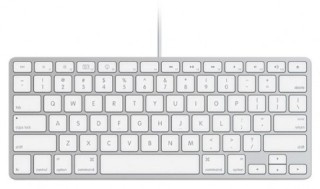
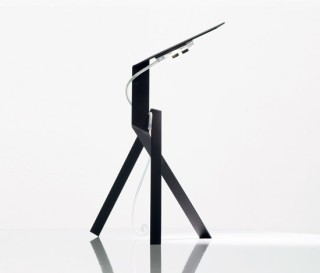
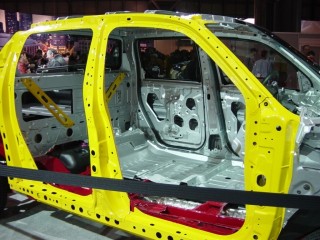
Tests
According to Consumer Product Safety Commission (CPSC) accident estimates, tens of thousands of stepladder accidents requiring emergency room treatment occurred annually in the United States. Approximately 85-90% of these accidents involve the user falling from the ladder and 8-9% of these injuries are serious enough to require that the victim be admitted to a hospital. In addition to posing a severe health concern, these accidents have significant loss-of-wages and high medical expense implications.
Having investigated numerous stepladder falls over the years, we have found it very common to learn that ladder accident victims are unaware of the cause of their falls and it is typical for them to respond to questions regarding causation with answers such as: "The ladder just gave way", or "It was sudden, I don't know what happened", or equivalent statements. One possible cause of such accidents is associated with use of the common four legged A-shaped stepladder, which can easily be accidentally positioned such that only three of its legs are contacting the ground.(...)
The danger of falling arises when the unsuspecting climber shifts his center of gravity, causing the ladder's elevated rear leg, to impact the ground. This is likely to occur when the user lifts one foot while stepping from one level to the next or shifts his weight while working. When this happens, large and rapid forces and the user's overcompensating reflexes can cause him to lose his balance and fall.
British scientists have discovered that getting someone to hold the bottom of a ladder while you climb it could do more harm than good.
Researchers at Loughborough University conducted 780 tests while working on a 200-page report into ladder safety that was commissioned by a Government safety watchdog.
The scientists decided that the age-old practice of holding your mate's ladder at the bottom could cause more accidents if the wrong technique was used. This was partly because "footing" the ladder - steadying it at the bottom with a foot - gave a ladder-climber a false sense of security.
The study concluded there were four main types of ladder accident.
These were: ladder sliding across a wall; ladder falling backwards; ladder "flipping" on one leg; and ladder bottom slipping. This last type of accident often caused death or severe wrist injury, according to data held by the Health and Safety Executive which funded the study.(...)
Accident Compensation Corporation figures show that step-ladder accidents cost New Zealand $17 million a year.
Last year the corporation dealt with 973 fresh claims from step-ladder injuries and 684 ongoing claims from earlier years.(...)
Report your accident

Accidents
A husband is being treated for shock after his wife was killed when he fell from a ladder while using a chainsaw.
The 56-year-old man, who has not been named, was pruning trees at the couple's home in Eltham, south-east London, when the accident happened on Monday afternoon.
Police said that his wife, who was also in her 50s, was not decapitated, but that she was killed instantly. Her husband was taken to hospital where he is being treated for shock.
A police spokesman said: "It was a really tragic accident. He is obviously in a great deal of shock."
A report is being prepared for the coroner and a post-mortem examination on the woman's body is to be carried out at Greenwich mortuary.
August 4, 2004.
A 45-year-old man died after falling from a ladder at work in Brooklyn Park, authorities said Saturday. Larry Auren of Cedar, Minn., was taken to North Memorial Medical Center in Robbinsdale after the accident Thursday afternoon. He died Friday morning of head injuries, according to the Hennepin County medical examiner. The accident was under investigation by Brooklyn Park police.
March 15, 1998.
A decorative painter lay fatally injured and alone overnight in the downtown St. Paul Public Library this weekend before his worried wife found him, according to the man's employer. After apparently falling from a ladder or scaffolding, Raymond Tatar was found unconscious but breathing Sunday morning inside the library, which is closed while undergoing a two-year $15.9 million renovation. He died Sunday night at Regions Hospital.
March 19, 2002.
Matthew Anson, 42, of Independence died Wednesday after coming into contact with a power line in Overland Park. Fire and rescue crews were called to the 9800 block of West 129th Street around 3 p.m., said Overland Park Fire Department spokesman Jason Rhodes.
Witnesses said a contractor working outside a house was moving an aluminum ladder that came into contact with overhead power lines, Rhodes said.
Crews transported Anson to a hospital where he was pronounced dead.
October 11, 2007.
Safety Tips
Only choose ladders with the UL seal from Underwriter's Laboratory. Ladders commonly come in three materials: aluminum, wood, or fiberglass. Aluminum is the most durable, but will conduct electricity, making it dangerous for use around electricity. Wood may rot. Fiberglass is the best combination of durability and non-conductivity, but is also the most expensive.
Make sure the ladder is suited for the type of job you plan to do
Before using a ladder, especially a ladder that has been stored in the garage for a while, inspect it for cracks or broken joints.
Place your ladder on a stable, even, flat surface. Never place a ladder on top of another object.
Use the 1:4 ratio to ensure a stable working platform. Place the base of the ladder 1 foot away of whatever it leans against for every 4 feet of height to the point where the ladder contacts at the top (see graphic).
When using an A-frame stepladder, make sure the brace is locked in place.
If climbing onto another surface, make sure the ladder extends at least three feet past the platform you're climbing onto.
Secure tall ladders by lashing or fastening the ladder to prevent movement.
Always face the ladder when climbing or descending.
Keep both feet on the ladder - never put one foot on a rung and the other foot on a different surface.
Do not climb higher than the second rung on stepladders or the third rung on straight or extension ladders.
Never stand on the top or the paint shelf of a stepladder.
Keep your belt buckle (if you have one) positioned between the rungs so it doesn't catch.
Never leave ladders unattended - kids love them.
When working with electricity, use a ladder made of wood or fiberglass.
Maintenance
Inspect ladders regularly. Stepladders and extension ladders should be inspected for broken or frozen joints or latches. Aluminum ladders should be inspected for cracks and broken welds. Aluminum ladders should also be inspected for rough spots and burrs before first use.
Wood ladders should be inspected for cracked wood, splinters, and rot. Look for broken or loose hardware. Protect wood ladders with linseed oil or clear sealant. Never paint a wooden ladder - the paint may hide imperfections such as rot or cracks.
Fiberglass ladders are protected with a clear sealant. If the fiberglass is damaged through the sealant, sand lightly before applying another coat of lacquer.
"Heaven" uses a novel construction technique, where the steps cantilever up from the base. This is unique in comparison with existing stepladders.
Library Steps - Chair/Ladder, 1810.
This ladder variation appeared in England in the last half of the 18th century in many forms, chiefly combined with benches, chairs, tables, etc. The ladder part unfolds, sometimes providing a handrail.
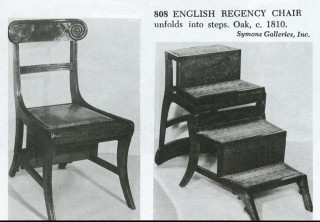
Step ladder Patent, Jerome Bell, 1952.
A purpose of the invention is to permit a step ladder to fold into a comparatively flat form and occupy a minimum of space in folded position, while at the same time having ample depth of step when the ladder is opened up, thus providing security and safety of tread on the ladder.
A further purpose is to provide a step positioning bar pivotally connected to the individual lower steps and below the top step, and preferably to make such bar extend parallel with the front rails.
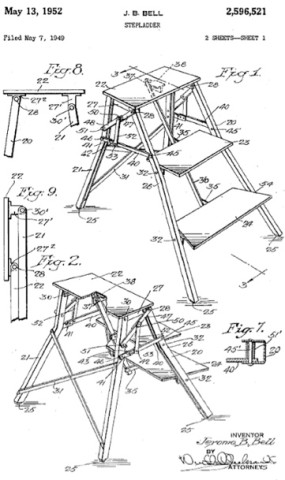
Rolling Step/Stool, Vestil Inc.
This variation is a combination of a short step ladder with a stool. It use is normally domestic, in home libraries, kitchens or garages.

Rolling Stepladder, Jean-Prouvé, 1951.
Jean-Prouvé always regarded himself as more of an engineer and constructor instead of a modern designer. He never designed for the sake of form alone, concentrating instead on the essence of materials, connections and production. Prouve himself was trained as a metal smith before attending engineering school in Nancy, and his intimate knowledge of metal remained the foundation of his work and career. After opening his own workshop in 1923, Jean Prouve began producing modern metal furniture such as this rolling step-ladder.

- Aronson, Joseph; “The Encyclopedia of Furniture”; Clarkson Potter, New York, 1965.
- books.google.com/patents?pg=PA3&id=wQdiAAAAEBAJ&output=text
- http://artcritical.com/DavidCohen/2009/DCProuve.htm
- www.jeanprouve.com/
- www.kotulas.com/wcsstore/KOTStore/images/product/146551_lg.jpg
- www.furnit.co.uk/magis-designed-by-marcelo-ziliani-flo-folding-ladder-cat-11-subcat-51-product-1903
World's tallest man marries small woman
Wednesday, March 28, 2007
After searching high and low, the world's tallest man has got married to a woman half his age - and two-thirds his height.
Bao Xishun, a 2.36 meter tall (7 foot 9 inch) herdsman from Inner Mongolia, tied the knot with saleswoman Xia Shujian, who was 1.68 meters (5 feet 6 inches) tall.
































































































